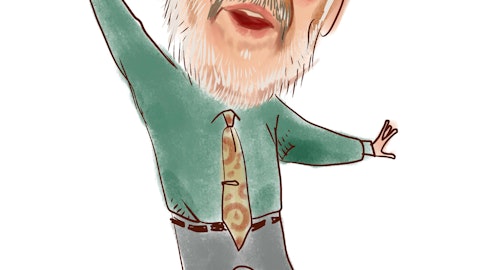Bed Bath & Beyond Inc. (NASDAQ:BBBY) is one of the largest U.S. retail chains selling domestics merchandise and home furnishings, and like many other brick-and-mortar stores, it has faced competition pressures from online retailers, as well as pressures from a weak economy and poor employment.
Hedge funds lost big when Bed Bath & Beyond lost 16% on its 1Q earnings release, but interestingly, many managers held onto their shares. Did they believe the selling was overdone? It would appear that they were only partially correct. Bed Bath & Beyond’s stock had managed to climb over 15% since its 1Q earnings release, reaching as high as $71.60, only a few dollars below its 52-week high of over $75 back in June. However, after its 2Q earnings release earlier this morning the stock tumbled 8.5%, all the way back down to $63.
The funds losing big on the 1Q release were Columbus Circle Investors, Royce & Associates, Renaissance Technologies, AQR Capital Management and Adage Capital Management. These were the top five hedge funds that owned the most shares of Bed Bath & Beyond during the first quarter (see all funds owning Bed Bath & Beyond here). All of the money managers that lost on the 1Q price drop were also Bed Bath & Beyond shareholders during the second quarter, according to their 2Q 13F filings, which means they likely have lost out again.
Of the five, it appears that Jim Simons with Renaissance capital may have made out the best; by reducing his position during the second quarter to 238,000 shares, he managed to cut his share count by 77%. Adage capital chose to stay relatively steady with only a 4% reduction in shares. This was also the case for Chuck Royce with Royce & Associates and Cliff Asness of AQR Capital Management. Donald Chiboucis of Columbus Circle Investors, much like Jim Simons, cut a large portion of his shares (43%), though he still held over 1 million of them at the end of the quarter. Columbus Circle has slowly been getting out of Bed Bath & Beyond, reducing share ownership by 24% in 4Q 2011, 25% in 1Q 2012 and 43% in 2Q 2012. We believe that many of these fund managers may continue to reduce their ownership in 3Q 2012.
A couple of hedge fund managers who initiated positions during the second quarter that also might be contemplating an exit after the 2Q earnings release are Curtis Macnguyen of Ivory Capital and Jeffrey Vinik of Vinik Asset Management, both purchasing around 400,000 shares. Also, Bill Miller of Legg Mason invested a small amount of his firm’s capital in Bed Bath & Beyond during 2Q.
From 2009 to 2012, Bed Bath & Beyond has managed to post a three-year CAGR in sales of 9.6%. The company has done a good job of increasing same store sales growth, averaging 6% over the same three-year period. However, one of the fundamental pressures for Bed Bath & Beyond is a weak housing market. After steep declines in housing from 2007 to 2009, housing starts did turn positive in 2010, with a 5.6% growth that year. This increase slowed in 2011 to 4.7% and we believe the rebound in housing will continue to be weak. As well, the company is faced with soft employment and credit tightening for its customers.
Bed Bath & Beyond faces direct competition from Williams-Sonoma, Inc. (NYSE:WSM), Pier 1 Imports, Inc. (NYSE:PIR), Kohl’s Corporation (NYSE:KSS) and Select Comfort Corp. (NASDAQ:SCSS). The competitive environment is not slack, with Bed Bath & Beyond also going up against stores such as Wal-Mart, Target, Macy’s and J.C. Penney, which all sell small appliances and linens. The risk of online competition continues to grow with Amazon recently launching Casa.com, which sells goods for the home, including blankets, sheets, towels, silverware and bakeware.
The company’s 2Q results showed EPS of $0.98, below the $1.02 consensus, and sales rose 12.1% to $2.6 billion, while comparable sales rose 3.5%, 10 basis points above consensus estimates. In addition, industry-specific indicators like average transaction amount and the number of transactions were both higher in the second quarter. However, there are concerns over long-term growth and market saturation, which also leads into valuation concerns. Of its peers, Bed Bath & Beyond seems to have the most saturation in its market, and is the largest company amongst them at $15 billion, as measured by market cap.
Bed Bath & Beyond trades at a P/E of 16, and the competitors come in at: Williams-Sonoma 19x, Pier 1 12x, Kohl’s 13x, and Select Comfort 26x. Moreover, P/S multiples are: Bed Bath & Beyond 1.7x, Williams-Sonoma 1.2x, Pier 1 1.3x, Kohl’s 0.7x, and Select Comfort 2.5x. The other three major home furnishings stores pay a dividend – Williams-Sonoma dividend yield 2.0%, Pier 1 0.8% yield, and Kohl’s 2.4% yield – while Bed Bath & Beyond currently does not. We believe that Bed Bath & Beyond could see a multiples-based contraction in addition to earnings contraction over the coming months, and it will be important to monitor this situation going forward.
For a complete look at the hedge fund industry’s sentiment toward this stock, continue reading here.





